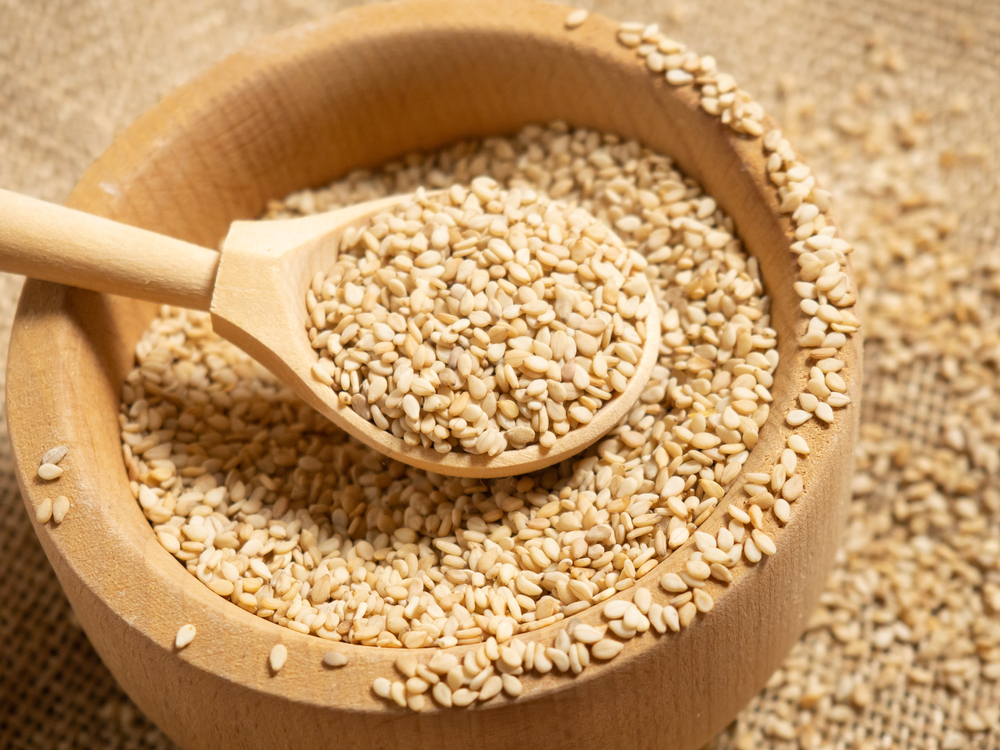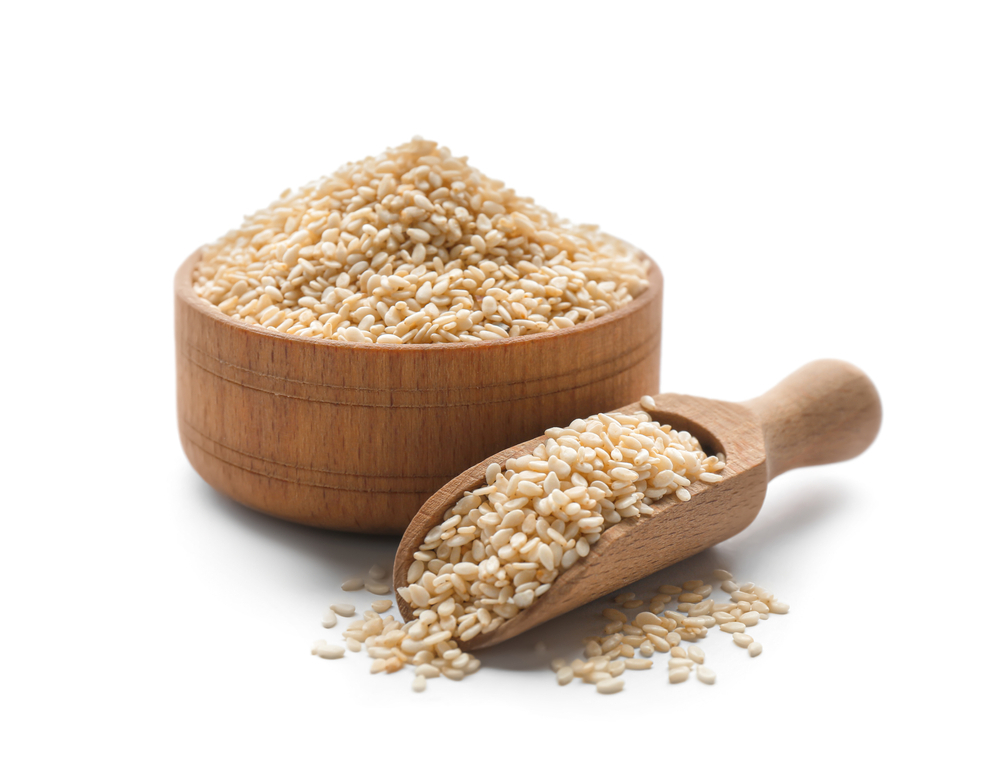Sesame uses:
The materials used in sesame are as follows:
- Tahini: It can be said that sesame tahini is one of the finest types of tahini ever, as tahini is extracted from sesame oil. In addition, tahini is included in many daily dishes. We may find it among the ingredients of bread and sweets.
- Sesame oil: It is worth noting that it is obtained by pressing sesame, and is included in many foods. It is used in making many sweets, and is also used in the field of cosmetics according to its many benefits for skin health.
- Sesame: It is a type of sweets famous in many Arab countries, in which sesame oil is mixed with sugar and honey and various nuts are added.
- Sesame flour: It is made by grinding sesame until it turns into a powder that is used by those who want to lose weight, as it is low in calories.
Nutritional value of sesame
Sesame contains a variety of nutrients per hundred grams of sesame, most notably the following:
- Calories : about 50% from fat.
- Iron : up to 78% milligrams.
- Carbohydrates : estimated at 23%.
- Calcium : 131 grams.
- Dietary fiber : 12%.
- Protein : estimated at about 18%.
- Beneficial fats : 48 grams.
- Magnesium : 346 milligrams.
- Sugar : 48 grams.
- Potassium : about 406 milligrams.
- Water : 5 grams.
Benefits of eating sesame on an empty stomach
Speaking of the best types of sesame, sesame has many benefits when eaten on an empty stomach, the importance of which is evident as follows:
- Maintaining heart health: Eating sesame contributes to reducing the risk of heart and arterial diseases, because it contains many antioxidants and unsaturated fats.
- Reducing blood cholesterol levels: Sesame contains some plant compounds such as phytosterols, which have an effective role in reducing harmful cholesterol and triglycerides in the body, in addition to strengthening the immune system.
- Maintaining blood pressure: Sesame contains magnesium, which in turn regulates blood pressure in the body, maintains heart health, and reduces the accumulation of toxic fats.
- Eliminating infections: Sesame contains antibacterial elements that protect the body from bacterial infections, and among these compounds is sesamolin.
- Enhancing the performance of diabetes medications: Sesame contains elements that in turn regulate blood sugar levels, such as pinoresinol.
- Fighting cancer: Sesame contains the compound sesamol, which acts as a powerful anti-cancer, as it supports the cell death process that contributes to the death of cancer cells.
- Strengthening hair: It is worth noting that when sesame oil is added to the scalp continuously, it contributes to strengthening the hair, making it soft and growing faster.
- Improving fertility in men: Sesame strengthens fertility and supports sperm production.
- Strengthening bones: Sesame contains elements that work to strengthen bones and heal them due to fractures and eliminate the problem of fragility.
- Improving the skin: Sesame contains zinc, which works to form collagen for the skin.
The most sesame producing countries
The most famous countries in sesame production around the world, the most prominent of which are the following:
Myanmar:
It is considered one of the largest sesame producing countries in the world, as its cultivation is characterized by the following:
- Sesame seeds are produced at a value of up to 18.3% annually.
- It produces about 890,000 tons of sesame seeds every year.
The State of India
India came in second place on the list of the largest sesame producing countries in the world, as it is considered one of the most important exporters of it. Sesame cultivation is characterized as follows:
- It produces about 626,000 tons of sesame seeds annually, due to its tropical climate that contributes to the cultivation of many crops, especially sesame.
- Sesame seed production in India reaches 13.1% annually.
The State of China
China has a wide reputation for producing sesame and exporting it to countries around the world, as it is included in the list of the top five sesame producing countries, and its cultivation is characterized by the following:
- It produces approximately 623,492 tons of sesame seeds annually.
- Up to 8% annually for sesame production.
Republic of Sudan
Sudan occupies fourth place among the top five countries that produce and export sesame seeds, with a production rate estimated at the following:
- It produces the equivalent of 560,000 tons of seeds annually.
- It occupies up to 11.5% of sesame production around the world.
The country of Tanzania
Tanzania was able to obtain fourth place in the production and export of sesame in the world, and here are the most important details:
- It produces approximately 420,000 metric tons of sesame seeds annually.
- The rate of sesame production in Tanzania is about 8.6% of the world’s sesame production.
How to grow sesame:
The method of growing sesame is as follows:
- The best time to plant sesame in the year is from mid-February to mid-March.
- Sesame cultivation is characterized by different methods. It can be grown in beds by scattering the grains. The area of the place does not matter. It can be grown in a small area by plucking the weeds and weeds present in the soil. After that step, broad lines and lines are made towards the soil.
- The seasons in which sesame is grown vary. It can be grown beginning in the fall months, from the beginning of September to the end.
- The possibility of planting sesame in the spring from late December to the end of one month of the new year.
- Sesame cultivation is in constant need of large fertilization. In addition, before the fertilization process, necessary analyzes are made of the soil in which sesame will be grown.
- After completing the planting stage, the soil is fertilized with triple phosphate.
- Sesame cultivation is in constant need of agricultural attention and irrigation.
- It is worth noting that the sesame plant is sensitive to water, so watering is done lightly at frequent intervals.
The success of irrigation depends mainly on the quality of the soil and the climate during cultivation.



